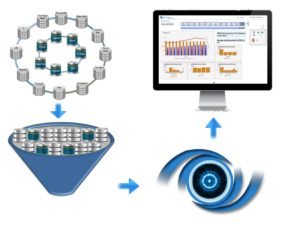4 Steps to Strengthen Operational Foresight: Step 1
Written by: Morgan Dove

Recently in the Helm360 blog, we discussed the processes and problems that come with implementing an analytics strategy across a business. By now, most organizations realize that a solid BI solution can no doubt drive business direction, improve performance and increase profits. However, you may be overwhelmed by the idea of a comprehensive BI strategy and decide that rather than approaching the subject, you’d rather take a nap. If your company is ready to make a change, I invite you to follow along as we share four simple steps to Strengthening Operational Foresight.
Data Aggregation: Find What You Need!
Data Aggregation is the first step to any BI strategy and is the process of gathering and measuring information based on variables of interest. Many businesses are implementing data aggregation into their company, including what is offered by Bamboo Solutions; a SharePoint list rollup allowing you to aggregate data. Let’s start with collecting the data. Firms acquire massive amounts of data that is typically stored across multiple sources and in varying formats (structure, unstructured, semi-structured). With limited accessibility to this “disparate data”, comprehensive reporting becomes a challenge.
With Thanksgiving just around the corner, I find myself in a similar challenge. I was recently informed that I am now at the age where I will “contribute” to the preparation of my family’s Thanksgiving feast. Therefore, I need to quickly review large sets of data (aka recipes) in order to produce three very specific outcomes – green bean casserole, cranberry sauce, and sweet potatoes/yams.
The green bean casserole and cranberry sauce are not significant concerns. It is the sweet potato casserole, which has me on a quest. I want to replicate the exact recipe I encountered years ago during my first experience at a high-end restaurant. To this day, I remember the deliciousness of the dish, and now I’m now involved in a serious data hunt to find that exact recipe.
Similar to my pursuit for the perfect recipe, firms need the ability to see, sort, and quickly assess information contained throughout the entire data ecosystem. A comprehensive solution should provide a standard set of KPI’s (key performance indicators), allow the flexibility to customize measures on the fly, and deliver real time insight (Intelligence on Demand) through dynamic visualization.
When firm leadership needs the answer to the decline of a particular practice group or client billing, they don’t need extraneous details from irrelevant information. A solution that removes unassociated data elements to represent a true root/cause analysis will provide insight to operational performance and improve decisions that produce stronger outcomes.
The firm needs to fine-tune its strategic planning, build an execution roadmap that is practical, and would inspire members of their team to work towards that goal. At this point, getting an okr certification to achieve that stratospheric growth might never be wrong. These additional experiences could help the leaders evaluate what exactly they can do to maximize the success of their teams.
It can also be related to my chase for the perfect Sweet Potato Casserole recipe. There are a myriad sources for food recipes: restaurants, television channels, cookbooks, food blogs, Internet searches, my grandma, etc… but I am looking for a particular holiday side dish. Searches that yield results for pot roasts or banana breads do not answer my question. I don’t need any recipe, only those containing the key words (KPI’s) “sweet-potato-casserole.”
Data Mining: Separating the amateurs from the Paula Dean’s
Another problem that often arises is the large amounts of “dark data”. Even with clearly defined KPI’s, a search can yield millions of possibilities due to stored data (72%) that does not have a clear business value. For example, a single Internet search of my key phrase yielded 7,650,000 results! How do we overcome the effects of dark data on our search for business intelligence?
Data mining is the process of exploring large amounts of data in search of consistent patterns or systematic relationships between variables. The ultimate goal is prediction – to derive a new, subset of data metrics that accurately predict desired or even detrimental outcomes.
In any firm, information may be gathered from multiple sources – 3E, Enterprise, Carpe Diem, CRM4Legal – and investigated to reveal a new subset of data: profit generation by an executive partner, for example. The problem arises when the wrong KPI is used to make decisions. Many businesses fall into the trap of thinking they can retrofit existing metrics to meet new business objectives. However, this strategy does not provide true insight into the things that matter the most. A successful BI strategy involves effort, and each organization should spend time thinking carefully about what information they need, where to find it, how to gather it, and why it will be of benefit.
Knowing what you’re looking for on the front end helps determine what information to collect. For example, I know my desired recipe did not include marshmallows or raisins and I remember that there were two specific layers of potato goodness: the sweet potato layer, and the brown-sugar-crunchy layer. Knowing these “metrics” as well as the restaurant where I experienced this dish quickly enabled me to sort through over seven million recipes to find the exact one!
Final Thoughts
I’d like to leave you with this final thought: understanding what your company needs from its data is often more important than the data itself. With the right information, your company can improve decision making, streamline business practices, and increase profits by gaining real time, operational foresight to elements impacting performance. As a result of my data search, I will treat my family to a succulent side dish. Now that you are all hungry, I will share the dish with you as well.


